![]()
It was not until the 1950’s and 60’s that studies of sea turtles were conducted indicating that sea turtle populations worldwide were diminishing. Dr. Archie Carr, a professor at the University of Florida, did extensive research on sea turtles in Florida and Latin America that was instrumental in enacting legislation to ensure their survival. Sea turtles are protected by International, National, and Florida state laws, and all species are classified as endangered or threatened for a number of reasons; fisheries interactions, coastal development, cultural practices, and ocean pollution are all areas of concern.
For more extensive information about threats to sea turtles, visit the Sea Turtle Conservancy.
Fisheries Interactions
Commercial and recreational fishing gear may accidentally capture, injure, or kill sea turtles. Shrimp trawls, longlines, and gill nets present the most danger to turtles.
Commercial fishing boats pull huge nets through the ocean to capture shrimp, which may also capture and drown sea turtles that must surface periodically to breathe air. Today, many countries, including the U.S., have laws requiring commercial fishing boats to install TED’s (turtle excluder devices). TED’s act as an escape door to allow turtles to push through a hole in the net, while smaller animals such as shrimp pass through the bars of the door into the net.
Longlines consist of numerous baited hooks strung out for miles and are responsible for hooking and drowning thousands of turtles each year. Turtles that do escape being hooked, may still become entangled in fishing line and suffer amputation, infection, or death.
You can help by purchasing seafood from turtle-friendly fisheries and encouraging your friends, family, and government representatives to do the same. Also be sure to properly dispose of used fishing line and do your part to help clean up our waterways.
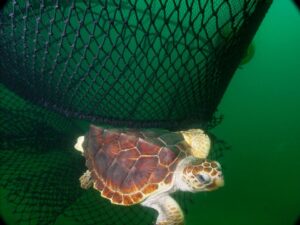
Photo Courtesy of NOAA
Coastal Development
Urbanization and development of coastlines throughout Florida has resulted in a huge reduction in the of the amount of suitable nesting habitat available for sea turtles to reproduce.
Practices such as coastal armoring alter the dune structure and increase beach erosion making it harder for nesting females to find dry, sloped sand in which to bury their developing eggs. Instead, nesting turtles in New Smyrna Beach often find themselves bumping into seawalls or rock revetments in search of a safe place for their young to develop.
People living along the beach may also cause harm to hatchling sea turtles by allowing the light from their homes to shine onto the beach at night. Visible light sources, reflective surfaces, and beach illumination from homes, condos, and businesses can cause hatchlings to become disoriented and crawl toward the dunes instead of the ocean. These disoriented hatchlings are at greater risk of predation by ghost crabs and raccoons as they wander the beach and inevitably exhaust their limited energy reserve that they require to swim to safety offshore.
Other obstacles such as deep holes dug in the sand and beach furniture may trap hatchlings causing them to perish or waist even more vital energy. You can make a huge difference for sea turtles on the beach by supporting dune planting and restoration as an alternative to armoring, shielding and turning off lights in beachfront properties, and cleaning up the beach when you leave by filling holes and removing beach furniture. If you are on the beach at night, please be sure to refrain from using flashlights or flash photography and do not block the path of hatchling or adult sea turtles.
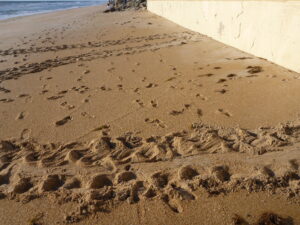
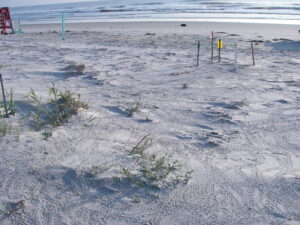

Marine Debris and Ocean Pollution
Ocean water contamination may result from oil and gas leakage, upland water runoff, release of toxic chemicals from plastic, and coastal construction.
The BP Deepwater Horizon oil spill in the Gulf of Mexico in 2010 had a huge impact on sea turtles. Virtually all of the sea turtle nests laid on the Gulf coast of Florida in 2010 had to be carefully excavated and transported to Florida’s east coast near Cape Canaveral. After completing incubation, the emerging hatchlings were released into the oil free waters of the Atlantic ocean; saving the lives of thousands of hatchlings who would have otherwise perished in the oil laden waters of the Gulf. Many aquariums and research facilities throughout the U.S. rehabilitated sea turtles that were found covered in oil. For more information on the oil spill, visit the Smithsonian Ocean Portal.
Pollution from beach trash and refuse discarded from boats also poses threats to sea turtles. Plastic bags and balloons floating in the water can look like jellyfish, the main food source for leatherback turtles, and may be accidentally ingested along with various other plastic debris. When turtles eat debris, it can get stuck in their digestive tract and cause a slow death from starvation. Turtles may also become entangled in lost or discarded fishing line, nets, and rope.
Floating marine debris is a serious threat to sea turtles and you can help reduce this threat by using reusable shopping bags and water bottles, participating in beach clean ups, and refraining from releasing balloons into the air. Using bilge socks and environmentally friendly cleaning products on your boat can also reduce ocean water contamination.
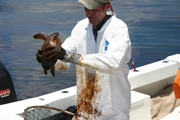
Photo courtesy of NOAA
Cultural Practices
The cultural history of tropical regions where sea turtles are found indicates that sea turtles have been a part of their diet, religion, and commerce for perhaps thousands of years.
Sea turtles in Florida were part of the diet of the Timucuans and other early native Indian tribes. Later, European settlers that came to Saint Augustine and the New Smyrna colony of Andrew Turnbull also ate turtle meat. Turtle eggs, meat, and turtle soup were considered quite a delicacy until recently. A famous Florida author, Marjorie Kinnan Rawlings, wrote about eating sea turtle eggs in her book Cross Creek Cookery, published in 1942. Fortunately, laws have now been passed in the United States to protect sea turtles and their eggs.
Even today, many people native to Africa, Asia, and tropical areas of Central and South America continue to legally and illegally harvest turtle eggs and meat. In addition, other parts of the turtle may be sold or traded including the oil, skin, and shell.
Many countries are now realizing the value of eco-tourism and taking steps to restrict the take of sea turtles and eggs. According to a study conducted by the World Wildlife Fund in Africa, Asia, Latin America, and the Caribbean, income generated by marine turtle eco-tourism totaled almost three times the amount generated by selling products derived from the turtles (eggs, meat, skin, shell).

Natural Predators
Natural predators such as raccoons, fire ants, and ghost crabs can threaten the survival of sea turtle eggs and hatchlings on the beach, while sharks and other large fish await them in the water.
While in the nest, turtle eggs in New Smyrna Beach may be subject to depredation by raccoons that dig up the nests and eat the eggs. In areas where this has occurred, a wire screen with holes large enough for the hatchlings to pass through is placed over the nest. At a later stage, when the hatchlings are ready to emerge, ants and ghost crabs may prey upon the eggs and hatchlings. If the hatchlings come out during the day, sea and shorebirds may feed upon them. After the turtles are in the ocean, sharks and other marine predators may make a meal of them.
As a survival strategy to offset these natural threats, turtles lay many eggs in each nest (average 100 eggs) and produce several nests (3-6 nests) each season. Perhaps only one hatchling out of about 5,000 will survive to maturity (15-30 years).
With so many natural threats to sea turtle hatchlings, it is important to minimize human disturbance to give them the best chance for survival.
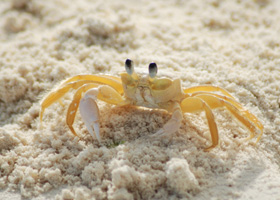
Please see our How to Help page for more information about what you can do as an individual to help reduce threats to sea turtles.